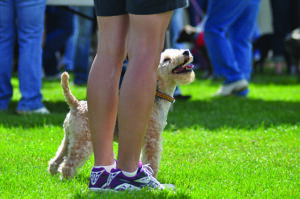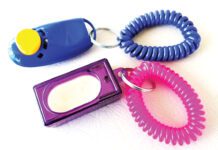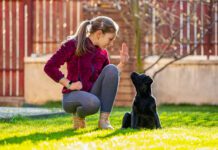
I’ve always talked to dogs – as I’m sure you do – engaging them with the usual cues, the names of favorite things and people, and a healthy dose of general chatter. But thanks to a week-long course in canine applied ethology taught by Kim Brophey, CDBC, CPDT-KA, of The Dog Door Behavior Center in Asheville, North Carolina, I’m now making a point to verbally name things in a way that gives the dogs I’m working with a clue about what’s next. The result? A notable decrease in anxiety, skittishness, and reactivity, plus an overall smoothing of household activity.
I know it sounds too simple, but I promise it’s a game-changer: Talk more to your dog!
THE MR. ROGERS HACK FOR TALKING TO YOUR DOG
“Dogs have the receptive language ability of a toddler.” When I heard Brophey say this in her course, and then go into the science supporting the statement, a lightbulb went on for me. I taught preschool before I pivoted to dogs, and I can tell you that, while most toddlers can’t articulate their thoughts very well, they understand an astounding percentage of what people say to them.
Note that we make an effort to tell toddlers what’s going on around them. That helps them gain confidence as they begin to see patterns in an otherwise confusing world. Think about the “Mister Rogers’ Neighborhood” show on PBS and that dear man’s predictably reassuring commentary on his actions (“I’m going to go over to the tank and feed the fish now.”).
Guess what? That purposeful narration works for dogs too, and Brophey calls it the “Mr. Rogers Hack.” She drives home the idea that so much of our human environment is utterly foreign to dogs, so they’re constantly having to work hard figuring out what the heck is going on. “Should I be worried? Should I be excited? Will I be interacting with that? Will it be loud? Can I eat it?” Cue the dog’s anxiety, skittishness, arousal, reactivity.
We can lessen a dog’s load by explaining life as it unfolds, just as Mr. Rogers did.
HOW NARRATION WORKS
This does not mean that we should all begin prattering on to our dogs about, say, global politics. The key is that the oft-repeated words and phrases must be relevant for the dog. When focused on things the dog has feelings about – either negative or positive – the Mr. Rogers Hack gives the dog a clue about what’s coming next, helping him to prepare.
For example, the other day I was walking my three big dogs and we turned a corner to find a construction crew working on the street. There were a handful of men, wearing reflective gear and hard hats, holding big tools, next to a noisy truck.
If I did nothing in that scenario I’d have a three-dog challenge on my hands: one barker, one slinker, and a highly suggestable 100-lb adolescent. Historically, my approach would have been to 1) switch direction or 2) use cues like “touch,” “look,” and “find it” to pull the dogs’ attention away from the crew and onto something familiar and reassuring as we pass by as quickly as we can. With three of them, though, that’s not always a graceful moment.
So I used the Mr. Rogers Hack, as I’ve been doing for the past few months. I exclaimed in a cheery voice, “Oh great, they’re fixing it!” My dogs relaxed – no stream of cues or distraction necessary. They were able to casually watch as we loose-leashed our way past the equipment and workers.
Why did this work? Because I have been consistently using that phrase – “Oh great, they’re fixing it!” – when there are unexpected humans working in unusual places doing strange loud things in weird clothing, and (here’s the key) none of that has affected them in any way.
“They’re fixing it!” allows my dogs’ brains to stop working so hard to figure out every single road/lawn/tree/paint/gutter/gardening/construction crew we come across. Those words help my dogs to categorize this experience because it’s part of a pattern they can recognize. They can now predict what’s next: We’ll continue our walk and that crew won’t impact us at all.
Ethology is simply the study of animal behavior; applied ethology focuses on the behavior of animals in the care of humans. Applied ethology allows a zookeeper to, say, find ways to help a captive cheetah stop pacing unhappily in his enclosure. (“What needs are unmet? How can we change the environment to fix that?”)
In her book, her courses, and her work at The Dog Door, Kim Brophey brings that applied ethology approach to our pet dogs, who are – even though we don’t like to think about it this way – in captivity. When it comes to undesired behavior – barking, digging, reactivity – dog trainers usually jump into changing that behavior. In contrast, Brophey’s model calls for slowing down that jump and instead spending time on “Why are they doing that behavior.”
If it sounds like that would lead to frustrated dog owners waiting for a solution, think again. Brophey’s process often results in the owner gaining not only a new understanding of the dog’s behavior but also many deceptively simple “hacks” (like the Mr. Rogers one profiled here) that can have a profound impact on the dog/owner relationship.
To learn more, check out “The Dog’s Truth,” Brophey’s engaging one-hour course on canine applied ethology; see the link on her website at familydogmediation.com.
SAMPLE VOCABULARY TO USE TO TALK TO YOUR DOG
It may be exhausting or arousing for a dog to have to evaluate every novel thing in our human environment and wonder how it might affect him. Using a word to indicate a category of things that will just pass on by is incredibly helpful, relaxing information for him. For example:
“Plane” = Anything loud in the sky
“Boat” = Anything floating in the water
“Bike” = A human moving fast on a bike, scooter, or skateboard
“Neighbor” = A random person we see out walking
“They’re playing” = Kids or teens racing around or being loud
“Runner” = Human moving fast on foot
“Doggy” = A dog we see but won’t greet up close
In contrast, here are words that can help a dog anticipate more interaction:
“Buddy” = A dog we’ll get up close to, sniff, walk with, or play with
“Friend” = A human we’ll say hello to
“Guest” = People coming into the house (this will telegraph that people will come in, sit around and talk)
“Helper” = A plumber, electrician, painter, or anybody coming into the house to work (may telegraph that person will be hanging out for a while, perhaps unsupervised by family, using tools, making noise)
It can be helpful (and just plain fun) to teach your dog things that come up every day, like:
“TV time!” = Snuggle in because we’ll be here for a while
“See ya later” = Go ahead and nap because I’m leaving for a while
“I’ll be right back” = Don’t follow me upstairs because I’m coming immediately back down
“This way” = We’re going to change direction
“First” and “Next” = For multiple-dog families training, putting harnesses on, getting in the car, being brushed, etc.
This deceptively simple shift in how we talk to our dogs is a great gift we can give them. Intentional, consistent, predictive narration creates calmer dogs – and thus, happier humans.






Thanks so much Kathy for writing this wonderful article! It really is exactly as you have stated. With my buddy I did this early on when he was a puppy. For example, I would say “I will be right back” and would get in my car and leave for 20 or so. He knew I truly would only be gone for a short period of time. Then I would say “I am going to a restaurant”. He knew over time that would be a longer interval,but…when I returned home,..he would get a leftover treat of steak LOL,..for being such a good boy! It is great to know I was doing this correctly. I talked to him all the time and it is true he relaxed in situations that may have otherwise confused him!
I’ve always talked to my dogs using as few words as possible because it’s much easier for them to understand what you want or what’s about to happen. For example, when I need to do something outside the fence, Bella will follow me to the gate. She gets anxious when I leave her and she would often lay down at the gate in the sun. If the sun is hitting there I will say Bella, shade, and she will lay down in the shade under a tree and wait for me. The way I first connected the action to the word, was to wait for her to go lay down in the shade when she got too hot in the sun and I would say shade Bella, good shade. She made the connection and now lays down in the shade instead of the sun to wait for me.
this brings up something i’ve been intrigued by; the dogs who have word boards and seemingly express themselves via the preprogrammed buttons. is this for real??? can WDJ do an article on this if it is a genuine method of communication???
Thank you for the interesting information on the subject of communication with our fur babies. I use short sentences, single words, hand gestures, and music to let my babies know what’s going on and what to expect in certain situations. If they are barking out the window at a strange vehicle or random people passing by, I look, then if all is ok, I give them the ok sign and say “it’s OK.” When we are leaving for more than a few hours I play James Taylor on Alexa and tell the pups that daddy is going to “the doctor.” For barking at familiar people and neighbors I say “no bark at neighbors” then “Quiet.” Anyway, these cues seem to have worked to decrease my dogs’ anxiety, especially the Lab rescue who had formerly been left alone in his crate for 10 hour days. It’s good to know I am on the right track!
Thank you! Great article. It seems most of these articles are just short introductory then, buy this book. Much appreciated to open an email and get a full article.
Amen to that!
Good article. I always talk to my dogs. When planning for surgery, I told her that she was going to see “Rob” (the vet tech, a stranger) and he will take care of her. “Rob” is a “friend”. Did this for weeks. Surgery day, she went immediately to “Rob”. Coincidence, I don’t know. They may not have the foggiest idea what you are saying, but they know they are getting attention.
I agree that the article is very intriguing — what I want to know is whether anyone has taken Ms. Brophy’s course”The Dog’s Truth,” and if so, what you thought of it. I have spent beaucoup bucks over the years taking any and every course to learn how to improve the life of my reactive dog and if this course had even one kernel of great information, I’d happily spend the $ 100. But to me, that’s a lot of money for a one hour course. Anyone have any information about the course? Please share!
I know it is important to be consistent with the words I use, but I can’t convince my husband, so he will use multiple words for the same thing.
Dogs are also VERY adept at understanding human body language, They can also cue off our body odours.
Which is why is important to remain calm, to help your dog through difficulties.
My almost perfectly behaved Shih Tzu, Louie, has one (and blessedly *only* one) bad habit. He is a scarfer. On our walks, he will pick up almost anything that’s within his reach, and being a low-to-the-ground breed, it’s grabbed very quickly. When we first got him, when I saw him grab something in his mouth, I’d put my finger in his mouth and sweep out whatever he’d grabbed…while usually “Spit that out!” even though he wasn’t spitting anything, I was sweeping it out of his moth with my fingers. One day, a week later, he grabbed something up and before I got to him, I distractedly said, “Louie,spit that out!” Which he promptly did, to my utter astonishment. I gave him a treat. Went home and told my husband what happened and he thought I was daft. But the next time he scarfed something up off the sidewalk, I said, “Louie, SPIT.” Which he did. And he’s done it on command ever since. He made the mental connection of my taking something out of his mouth with the word “SPIT” and figured out I wanted him to spit it out of his mouth himself. He is an extremely intelligent dog I’ve found. In fact, he not only understands language, but he recognizes specific music. I have made individual ringtones for family members and good friends. Louie doesn’t bat an eye when any of the 6 different ringtones play. BUT, the one I have for my husband is Mozart’s 25th Symphony. When Dan calls, it usually means he’s on the way home to pick me up, hence I’ll be leaving soon. When that musical snippet plays, Louie jumps up, and runs over to me watching to see if I’m getting ready to leave—wagging his tail hoping I’ll take him too! He recognizes specific musical note progressions. I think that’s rather amazing.
I found this article very fascinating. To be honest with all, I believe God gave me this blessing to work with Dogs at a very young age. At age 4 I went to bed only to wake paralyzed with polio for 120 days. I would constantly ask my mother about dogs & after marrying my mother gave me my baby book. Ironically she had wrote Scotty loves horses and dogs at age 3, 4, & 5. As a child we hunted & my job was to take care of our many hunting blue ticks & coonhounds until I was 18. Fast forward to 2003 when I knew there had to be something better in life then killing myself as a Management Leader at Verizon. After much prayer, I had 26.5 years with points to retire, and I left in October 2003 at age 49. By this time I already had 2-German Shepherds one of which I drove from Tampa to Perry GA to compete in the German Shepherd Nationals. I love obedience & agility, but Oksana was really good at obedience and held our own taking 4th place. But I spoke to her a lot many times not thinking about what I said?
In 2004 I decided I needed to work with kids to give back. I bought my first Golden Retriever from a Duck Hunter. Everyone I trained with said no to hyper & full of energy? I did it any way & boy was I blown away. Well unlike most dog people I knew I was meant to be working with dogs & kids. God gave me a journey of a life time. Beyond anything I could have imagine. That Duck dog became so smart over his 14.5 years many times I had think up of other ways to out smart him.
Our 1st year I put 1600-1800 hours of training 90% of that was at home with no stress. I talked to this kid so much I’m sure anyone listening must have thought I was nuts? At 20 weeks old St Joseph Hospital reluctantly allow us to come to the hospital after he had already passed their training test. You see I had this kinda of prodigy of a dog & I knew he was smart, but it went beyond smart. We volunteered together for 10.5 yrs as we walked the halls, state attorney office[sexual abuse-30 cases], special need program director 3 years, and etc… In those 10years we logged a little over 5000 hours visiting and touching over 5000 kids. His name LAVIE [call name LA] LAVIE in French meant The Life & what a Life he had.
Sometimes I thought he was reading my mind & I’ve never experienced anything like it.
Great article. I’ve been doing it inadvertently and realised that my dogs have picked up some words to good effect but will make more of a point of it from now on.
Excellent idea. I talk to my dogs but I don’t organize it like this so there isn’t repetition and planning. With my previous dog I did use “oh boy!” for something pleasant, “dinner” and “I’ll be back.” But yes, toddler is a good comparison. They can understand a lot more than they can articulate.